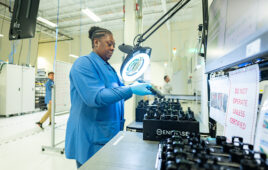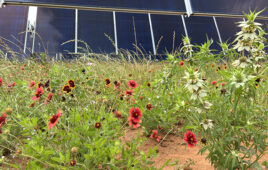By Ben Izard, Corporate Business Development, NaturChem
The solar industry has seen exponential growth in recent years. This growth is being accelerated by a shift in culture which prioritizes renewable energy as well as state laws that incentivize the industry. The United States is forecasted to install nearly 100 GW of solar between 2021 and 2025 — 42% more than was installed over the last five years. Growth of this magnitude in a newer industry can pose challenges that could lead to potentially expensive learning curves.
 Proper stormwater management throughout the construction process is vital to the overall success of a solar project, the local ecosystem and support from the surrounding community. The NPDES Stormwater Program requires permits for discharges from construction activities that disturb one acre or more. The people involved in a new project view the construction general permit (CGP) the same way people view boat ownership. The two best days of your life are the day you buy a boat and the day you sell it, or in this case, the day you open a CGP and the day you close it. An important step in this process is the notice of termination (NOT) of coverage under an NPDES general permit for stormwater activity discharges associated with construction activity. In most regions, this is completed by proving that final stabilization has been achieved throughout the site. Final stabilization is an important part of responsible stormwater management, but it alone does not constitute success.
Proper stormwater management throughout the construction process is vital to the overall success of a solar project, the local ecosystem and support from the surrounding community. The NPDES Stormwater Program requires permits for discharges from construction activities that disturb one acre or more. The people involved in a new project view the construction general permit (CGP) the same way people view boat ownership. The two best days of your life are the day you buy a boat and the day you sell it, or in this case, the day you open a CGP and the day you close it. An important step in this process is the notice of termination (NOT) of coverage under an NPDES general permit for stormwater activity discharges associated with construction activity. In most regions, this is completed by proving that final stabilization has been achieved throughout the site. Final stabilization is an important part of responsible stormwater management, but it alone does not constitute success.
With the growing trend of regulated post-construction best management practices (not just temporary sediment basins) and increased regulatory enforcement from local municipal separate storm sewer systems (MS4s), the solar industry needs to get ahead of the issue instead of being forced into a reactive learning curve that is expensive to remedy. This curve can be inflated by how a new solar project is set up. Company A is hired to complete all EPC related activities. Once production testing is completed and the site can generate power, Company A is on to the next project. Company B steps in at this point to handle all O&M-related activities. Company B arrives on site to find that it is now responsible for maintenance within a strict budget, and the site is riddled with stormwater maintenance issues such as ruts/rills, sediment build-up compromising the capacity of a basin, eroded berms, remaining silt fence, changes from spec’d drawings, etc. Everyone in the industry is likely familiar with this nightmare and the finger-pointing/blame game that begins. This blame game can get expensive, and, until the issues are resolved, the environment takes the brunt of the punishment.
One way to prevent these issues from occurring is utilizing O&M vendors to conduct site inspections before Company A moves on to the next project. Company A is an expert in the EPC field and desires to provide an excellent product for the customer when it is finished. Also, Company B is an expert in the O&M field and desires to provide an excellent product for the customer for the next 20 years. If Company A and Company B don’t communicate their individual expert knowledge throughout the EPC process, they can’t deliver the best long-term product to the customer. An important step in this process is having Company B perform a “NOT” inspection for the customer, prior to the regulatory inspection. This promotes crucial communication between all parties and allows the EPC time to correct any issues while its resources are still on site. It also allows the EPC to head to the next project without loose ends and allows the O&M contractor to step into the project set up for success.
Thorough communication among all parties during the entire life cycle of construction provides the customer with the best final product and protects the environment while staying on top of all regulatory requirements.





“With the growing trend of regulated post-construction best management practices (not just temporary sediment basins) and increased regulatory enforcement from local municipal separate storm sewer systems (MS4s), the solar industry needs to get ahead of the issue instead of being forced into a reactive learning curve that is expensive to remedy. This curve can be inflated by how a new solar project is set up.”
Goes back to the argument that solar PV should be installed on the roof of the home or business that is using the power. Use large commercial and industrial buildings for local large array solar PV and set up shaded parking with solar PV coverings. In these instances all of the “real estate” is already laid out and the drainage of building and parking structures have been done when the construction phase of the project is performed.